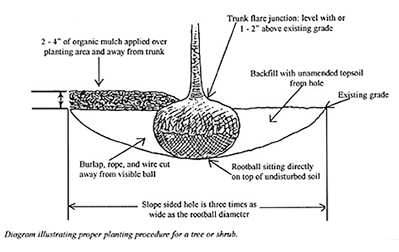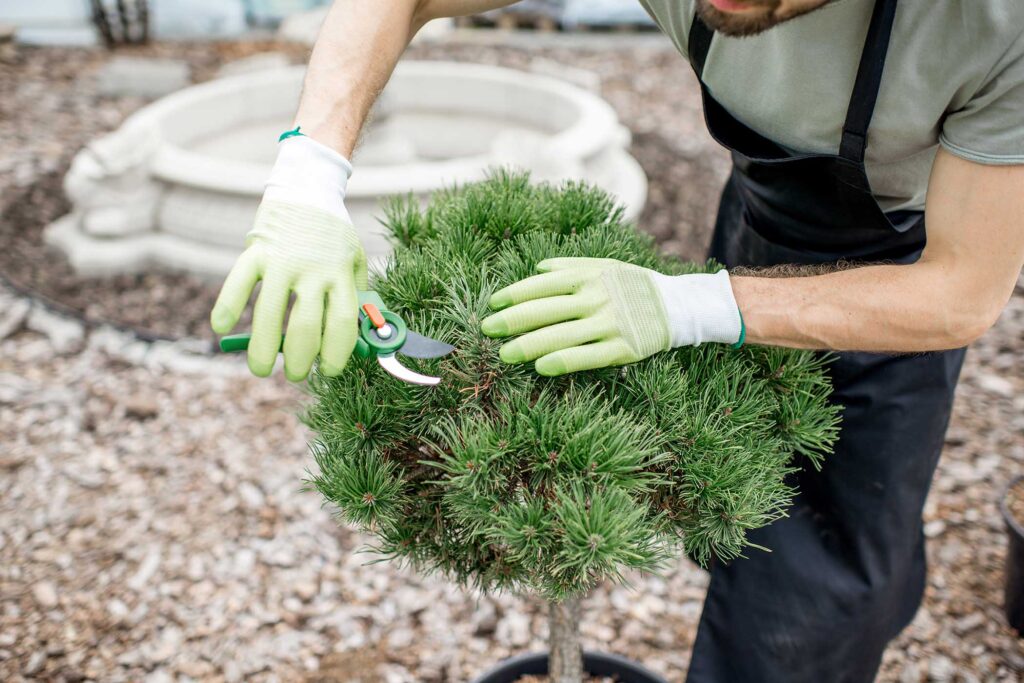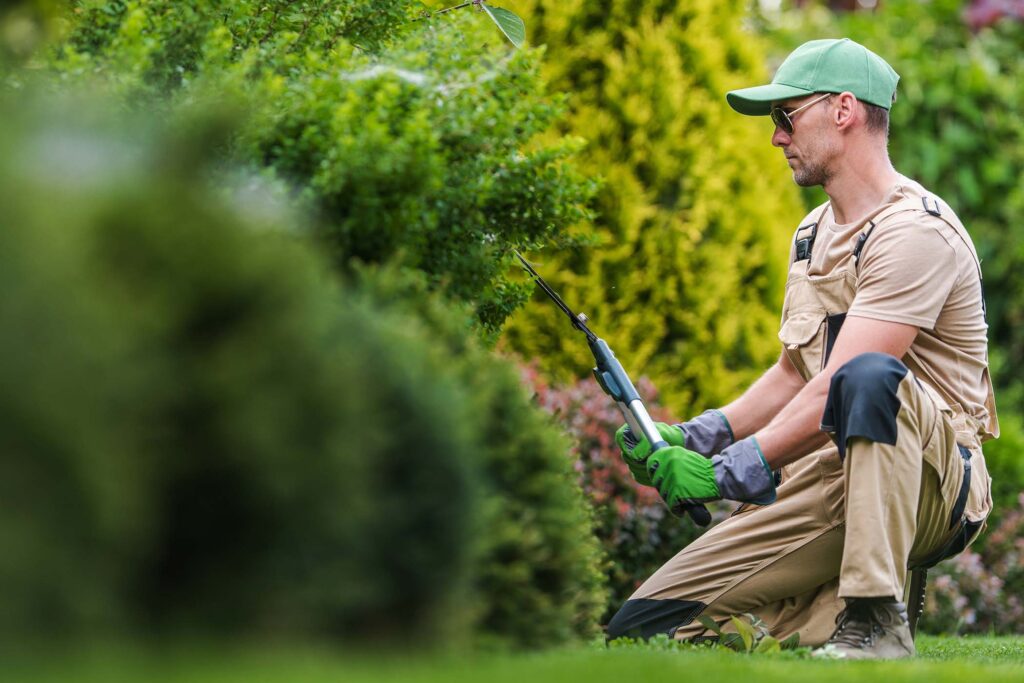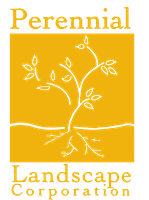Perennial Landscape Corporation of Massachusetts
Planting and Maintaining Trees and Shrubs
- Home
- Blog
Planting and Maintaining Trees and Shrubs

In regards to the planting and maintenance of woody plants, many of the established cultural guidelines practiced by landscape professionals have undergone scrutiny in recent years. Based on research findings and field observations, many of these practices have been modified or changed in order to improve overall plant health in a landscape setting.
Improper planting techniques, particularly planting too deep, have been shown to be a major cause of tree mortality in managed landscapes. In addition, research has shown that accepted practices governing the size and shape of the planting hole and the nature of the backfill mixture require some modification.
Backfilling the Planting Hole
According to research, backfilling with soil dug from the planting hole is preferable to mixing the soil with large amounts of organic soil amendments such as peat moss, compost, etc. The addition of an organic soil amendment may be called for if the existing soil is of poor quality, such as excessively sandy or heavy clay soils or those consisting of undesirable fill material. Alternatively, quality topsoil, similar in texture to the existing soil, may be brought in and used for backfill.
While backfilling the hole, it has been customary to tamp the soil to avoid leaving large air pockets. However, this practice often results in the soil being packed so firmly as to drive out all the fine air spaces needed for a well-aerated soil. An alternative to tamping the soil would be to water the soil halfway through the backfill process and allow it to drain. When the water has drained away, resume backfilling and water again thoroughly. If the practice of tamping the soil is chosen, it should be done lightly so as to not compact the soil in the planting hole.
To complete the backfilling, smooth the surface soil and check to ensure that the trunk flare is completely exposed. (The structural roots should be within the top 3 inches of soil as measured 4 inches from the trunk.) Water the rootball and planting area immediately after backfilling.
Tree Wrapping
The bark on a tree or shrub is as important as skin to an animal. It acts as a barrier to exclude insects and disease organisms from the vascular system, which lies directly under the bark. Some bark injuries may occur because of damage from the sun (sunscald) or temperature extremes (frost cracks). For many years, it has been a common practice to use tree wrap on newly planted or thin-barked trees in an effort to reduce sun or temperature damage to the bark.
Research has found that some tree wraps may not provide the protection that was originally intended. In experiments using plastic tree guards on dogwoods, large numbers of dogwood borers were found under the guards while few were found in trees without guards. In addition, some tree wraps were found to retain excess moisture beneath the wrap. This may encourage fungal or bacterial growth, especially if there were pre-existing wounds in the trunk.
If tree wrap is to be used, it is recommended that appropriate material be selected, checked frequently, and the wrap be removed during periods of active growth.
It is hoped that these guidelines, together with the selection of appropriate and healthy plant material, will be of help in promoting improved plant health in the landscape.
Written by: Deborah C. Swanson – Revised – 01/2012
References:
• Appleton, B. L., Ph.D., “Questioning Tradition,” American Nurseryman, Sept. 1, 1993.
• Harris, R. W., Ph.D., Arboriculture: Integrated Management of Landscape Trees, Shrubs and Vines, 2nd ed., Regents/Prentice Hall, Englewood Cliff s, NJ; LCC#91- 19477
• Kujawski, R., Ph.D., and Ryan, H.D., PhD., Fertilizing Trees and Shrubs, UMass Extension IPM Fact Sheet series, July 2000.
• Shigo, A. L., Ph.D., Modern Arboriculture, National Arbor Day Foundation Bulletin No. 19, 4 Denbow Road, Durham, NH 03824-3105.
• Watson, G. W., Ph.D. and Himelick, E. B., Principles and Practice of Planting Trees and Shrubs, 1997. International Society of Arboriculture, PO Box GG, Savoy, IL 61874.
• Whitcomb, C. E., Ph.D., Establishment and Maintenance of Landscape Plants, Lacebark, Inc., Stillwater, OK; LCC#87-50632



About Perennial Landscape Services
Creating distinguished landscape environments in Winchester, Lexington, Concord, Weston, Wellesley, Lynnfield, Carlisle, Andover, Bedford and surrounding Massachusetts’ communities since 1995.
Create your own perfect outdoor living area from start to finish with our complete landscape design and landscape construction services!
Services include:
- Stone Walls, retaining walls and masonry
- Landscape lighting
- Patios and walkways — all types
- New lawns, grass seeding and sod installation
- New plantings
- Waterfalls and ponds
- Fencing
- Plant and shrub installation
- Bobcat work and grading
- Pruning trees and hedge trimming
- Spring clean-ups and Fall clean-ups
- Lawn mowing
- Full service all-season maintenance for lawns and gardens
- And much more!
Please note: When we start your project we will be on-site until the job is 100% complete!
Sample Lawncare Maintenance Program
March/April — Spring clean up, thatch lawn, install mulch,
re-edge beds and remove all debris.
July/August — Prune and trim all shrubs and hedges. Weed all existing planting beds.
September — Aerate lawn and mowing.
October/November — Fall clean up, rake leaves and remove all debris. One clean up to be done mid to late October, two clean-ups in November, weather permitting.
- Lawn Mowing — Once a week, including trimming and blow down of all walks, walkways, edges and appropriate areas. (4 cuts per month, 5th is additional)
- Weeding — Available on a monthly or as needed basis.
Post Tags :

Scott Carzo
Owner & Founder
Creating distinguished landscape environments in Winchester, Lexington, Concord, Weston, Wellesley, Lynnfield, Carlisle, Andover, Bedford and surrounding Massachusetts’ communities since 1995.

Scott Carzo
Creating distinguished landscape environments in Winchester, Lexington, Concord, Weston, Wellesley, Lynnfield, Carlisle, Andover, Bedford and surrounding Massachusetts’ communities since 1995.
Have a Question?
Whether you have landscape construction needs large or small, fall cleanups or if you’d just like to say hi, we would love to hear from you.
